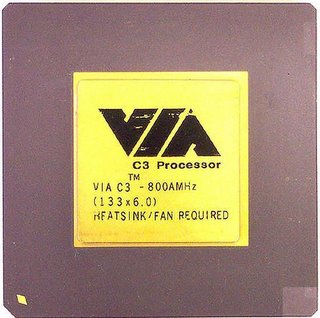June 20, 2007
November 10, 2006
Pentium III - 800Mhz 2 variants

Donated by the group IT guys at Golley Slater, I now have in my possession to types of Slot 1 Pentium III's running at 800MHz. They are both Coppermine CPU's (256KB of Level 2 cache), one running with the 100MHz Front side bus and another with the faster 133MHz FSB.
While the SECC2 cartridge package in which they are housed is a beautiful bit of design, it isn't as solid in construction as the old SECC1, in fact it's positively flimsy.
The move to Slot1 was prompted when Intel lacked the technology to get the level 2 cache on chip, so a larger module was required. This coupled with fact that imitators may have wanted to compete with them and utilise their next socket after Socket 7, meant that a completely different contact method flumoxed the likes of Winchip and Cyrix. Even AMD, who had the same problem with initial designs of the Athlon moved to a Single Edge Contact Cartridge but no one ever copied the Intel design.
By the time these chips were released, Socket 370 had blossomed into the mainstay for many years (the Celeron was produced with it's cache on board earlier on, due to being only 128kB).
At 800MHz, these chips with runs most apps today, they don't struggle with Windows XP, Office 2003 or any DVD or MP3 players. You wouldn't want to game with it tho...
November 08, 2006
Pentium IV - 1.9GHz - Willamette

The second incarnation of the Pentium 4 was offered in Socket 478 form, but it was the same core as it's disastrously slow predecessor. The 256Kb of Level 2 cache and the Netburst core weren't a good combo, but at 1.9GHz it was at least capable of most tasks thrown at it.
Of course, AMD's Athlon murdered it in most benchmarks. See the Northwood core 3.0GHz CPU elsewhere on this site to see the difference 512Kb of cache and ludicrously high clock speeds made.
This particular CPU is relegated to being part of my HTPC (Home Theatre PC), as it sits in a stupidly quiet DELL case. Married with 512MB of PC133 Ram, this system is only good enough
November 03, 2006
August 29, 2006
Via C3 - 800MHz

The Samuel was VIA's rework of the old Winchip core. It was not a great performer due to the lack of L2 cache.
However, this Samuel 2 has 64KB of Level 2 cache and is capable of using 3DNow and MMX instructions. The Samuel 2 core is very simple but has excellent branch prediction (which is needed with such a small L2 cache). It has a much smaller die and power requirements than a comparative Intel Pentium III (20 Watts) or AMD Athlon (25 Watts). They make ideal HTPC CPU's. The Samuel 2 is known as the first really successful CPU by VIA. It is more then capable of running any and all office app's as well as basic multimedia.
June 20, 2006
June 19, 2006
Fastest Athlon XP on the block

My beloved Athlon XP-M 2600+. Should run at 2GHz - Runs at an astonishing 2640Mhz! She has the best of the best cores - the IQYHA week 52, 2003. She's a Barton so she has 512kB of cache - twice that of her Thoroughbred B sister below. She's currently purring away in an ABIT NF7-S V2.0(far and away the best Socket A motherboard)with the help of a Thermalright 947U.



